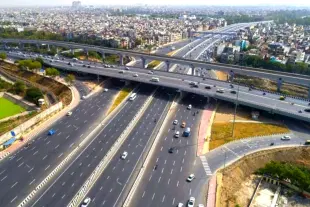Infrastructure
Economic Survey 2023-24: Public Sector Dominates Infrastructure Investments; Calls For Boost In Private Sector Funding
V Bhagya Subhashini
Jul 22, 2024, 04:24 PM | Updated 04:24 PM IST
Save & read from anywhere!
Bookmark stories for easy access on any device or the Swarajya app.


Economic Survey 2023-24 has underscored the necessity of boosting private sector financing and mobilising resources from new sources to enhance India's infrastructure.
India has invested a total of Rs 53.9 lakh crore trillion on infrastructure between fiscal years 2020-2024, as per the survey.
The survey revealed that infrastructure development in India is primarily driven by the public sector. From fiscal years 2019 to 2023, the central government contributed 49 per cent, state governments 29 per cent, and the private sector 22 per cent of the total infrastructure investments.
To boost private capital expenditure, the survey emphasised the need for policy interventions by the central government, with significant support from state and local governments, reports Deccan Herald.
The Economic Survey 2023-24 has reported a significant 12 per cent year-on-year increase in capital expenditure, reaching Rs 15.8 lakh crore. This growth is primarily focused on infrastructure-intensive sectors such as roads and highways, railways, and housing and urban affairs.
The survey also highlighted the success of various international initiatives, such as pooled financing mechanisms for municipal projects, specialised municipal intermediaries, asset recycling programs, tax increment financing, and land sales and development rights. These initiatives could potentially be adapted to the Indian context to enhance infrastructure financing.
A crucial area identified by the survey is the improvement of data capture and reporting mechanisms for infrastructure investments across various instruments and sectors. Enhanced data collection and analysis at a granular level are essential for understanding the composition and performance of different projects.
"Major strides have been made since the Rangarajan Commission Report on Infrastructure Statistics (2001) to collect data on policy direction, institutional strength, project performance, and monitoring. However, data gaps persist in some key areas," the Economic Survey pointed out.
The survey highlighted inconsistencies in the frequency of data collection, lack of uniformity in methodology, and cross-fund flows between institutions, which can lead to double counting.
These issues need to be addressed to provide a comprehensive macro-level overview of infrastructure spending and development based on Harmonised List (HML) classifications.
V Bhagya Subhashini is a staff writer at Swarajya. She tracks infrastructure developments.




